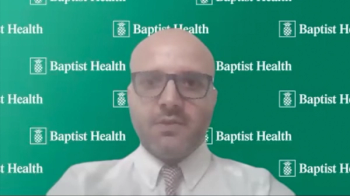
Savolitinib Combo Earns Priority Review in China for EGFR+ NSCLC
Findings from the phase 3 SACHI trial support the National Medical Products Administration’s priority review designation for savolitinib/osimertinib.
China’s National Medical Products Administration (NMPA) has granted priority review to a new drug application (NDA) for savolitinib (Orpathys) plus osimertinib (Tagrisso) as a treatment for those with locally advanced or metastatic non–small cell lung cancer (NSCLC) harboring an EGFR mutation with MET amplification following progression on frontline therapy with an EGFR inhibitor, according to a press release from the developer, HUTCHMED Limited.1
Supporting data for the NDA came from the phase 3 SACHI trial (NCT05015608), in which investigators assessed the safety and efficacy of the savolitinib combination vs platinum-based chemotherapy in this NSCLC population. A planned interim analysis conducted by an independent data monitoring committee indicated that the experimental regimen had reached the trial’s primary end point of progression-free survival (PFS); enrollment for the study has ended. Investigators will submit data from the SACHI trial for presentation at a future scientific meeting.
“This marks the first regulatory filing for the [savolitinib] and [osimertinib] combination. The combination has demonstrated clear evidence to address MET-driven EGFR-inhibitor resistance and offers a continued path for oral treatment,” Michael Shi, PhD, head of Research and Development and chief medical officer at HUTCHMED, stated in the press release.1 “With our biomarker-specific approach, we are hopeful to enhance treatment continuity and quality of life for [patients with] NSCLC navigating this challenging journey….We hope to bring this all-oral, chemotherapy-free treatment option to patients with MET-driven lung cancer in the near future.”
Previously, investigators announced that the first patient enrolled on the SACHI trial had received their first dose of study treatment on November 22, 2021.2
In the multicenter phase 3 SACHI trial, an estimated population of 250 patients were randomly assigned to receive savolitinib orally once per day plus osimertinib orally once daily every 3 weeks or pemetrexed in combination with platinum every 3 weeks.3
The trial’s primary end point was PFS per RECIST v1.1 criteria. Secondary end points included objective response rate (ORR), disease control rate (DCR), duration of response, overall survival, time to response, and safety and tolerability.
Patients 18 to 75 years old with histologically or cytologically confirmed unresectable locally advanced or metastatic NSCLC, EGFR mutations prior to first-line EGFR tyrosine kinase inhibitor (TKI) therapy, and radiologically documented disease progression following frontline treatment were eligible for enrollment on the trial. Additional eligibility criteria included having an ECOG performance status of 0 or 1, an expected survival duration of more than 12 weeks, adequate organ function or bone marrow reserve, and the ability to swallow oral medication.
In June 2021, savolitinib received conditional approval from the NMPA in China as a treatment for patients with NSCLC harboring MET exon 14 skipping alterations following progression on prior systemic therapy.4 The approval was based on results from a phase 2 trial (NCT02897479), which included patients with the pulmonary sarcomatoid carcinoma (PSC) subtype of NSCLC.
After a median follow-up of 17.6 months, phase 2 data showed an ORR of 42.9% (95% CI, 31.1%-55.3%) and a median PFS of 6.8 months (95% CI, 4.2-9.6) with savolitinib across the overall population. Additionally, the agent yielded clinically meaningful PFS across patient subgroups.
Savolitinib produced an ORR of 40.0% (95% CI, 21.1%-61.3%) for patients with the PSC subtype and 44.4% (95% CI, 29.6%-60.0%) for those with other NSCLC subtypes. Across the overall population, the DCR was 82.9% (95% CI, 72.0%-90.8%).
The safety and tolerability of savolitinib in the phase 2 trial were comparable with prior reports of the agent; investigators observed no new safety signals.
References
- HUTCHMED announces NDA acceptance in China with priority review status for ORPATHYS® and TAGRISSO® combination in lung cancer patients with MET amplification after progression on first-line EGFR inhibitor therapy. News release. HUTCHMED Limited. January 2, 2025. Accessed January 6, 2025. https://tinyurl.com/mrxs6af4
- HUTCHMED and AstraZeneca initiate SACHI phase III trial of ORPATHYS® and TAGRISSO® combination in certain lung cancer patients in China after progression on EGFR inhibitor therapy. News release. HUTCHMED Limited. November 24, 2021. Accessed January 6, 2025. https://tinyurl.com/y4hew47k
- Study on savolitinib combined with osimertinib in treatment of advanced NSCLC with MET amplification (SACHI). ClinicalTrials.gov. Updated March 30, 2023. Accessed January 6, 2025. https://tinyurl.com/5n7ywcd8
- Orpathys approved in China for patients with lung cancer and MET gene alterations. News release. AstraZeneca. June 23, 2021. Accessed January 6, 2025. https://tinyurl.com/4sbbcp9s
Newsletter
Stay up to date on recent advances in the multidisciplinary approach to cancer.



















































































